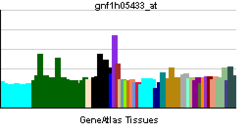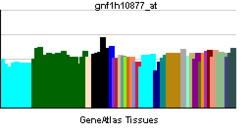- OR51I2
-
Olfactory receptor, family 51, subfamily I, member 2 Identifiers Symbols OR51I2; OR11-38 External IDs MGI: 3030475 HomoloGene: 17489 GeneCards: OR51I2 Gene Gene Ontology Molecular function • receptor activity
• olfactory receptor activityCellular component • plasma membrane
• integral to membraneBiological process • sensory perception of smell
• response to stimulusSources: Amigo / QuickGO RNA expression pattern 


More reference expression data Orthologs Species Human Mouse Entrez 390064 259075 Ensembl ENSG00000187918 ENSMUSG00000073932 UniProt Q9H344 n/a RefSeq (mRNA) NM_001004754 NM_147072.1 RefSeq (protein) NP_001004754 NP_667283.1 Location (UCSC) Chr 11:
5.47 – 5.48 MbChr 7:
111.19 – 111.19 MbPubMed search [1] [2] Olfactory receptor 51I2 is a protein that in humans is encoded by the OR51I2 gene.[1]
Olfactory receptors interact with odorant molecules in the nose, to initiate a neuronal response that triggers the perception of a smell. The olfactory receptor proteins are members of a large family of G-protein-coupled receptors (GPCR) arising from single coding-exon genes. Olfactory receptors share a 7-transmembrane domain structure with many neurotransmitter and hormone receptors and are responsible for the recognition and G protein-mediated transduction of odorant signals. The olfactory receptor gene family is the largest in the genome. The nomenclature assigned to the olfactory receptor genes and proteins for this organism is independent of other organisms.[1]
Contents
See also
References
Further reading
- Bulger M, van Doorninck JH, Saitoh N, et al. (1999). "Conservation of sequence and structure flanking the mouse and human beta-globin loci: the beta-globin genes are embedded within an array of odorant receptor genes". Proc. Natl. Acad. Sci. U.S.A. 96 (9): 5129–34. doi:10.1073/pnas.96.9.5129. PMC 21828. PMID 10220430. http://www.pubmedcentral.nih.gov/articlerender.fcgi?tool=pmcentrez&artid=21828.
- Bulger M, Bender MA, van Doorninck JH, et al. (2001). "Comparative structural and functional analysis of the olfactory receptor genes flanking the human and mouse beta-globin gene clusters". Proc. Natl. Acad. Sci. U.S.A. 97 (26): 14560–5. doi:10.1073/pnas.97.26.14560. PMC 18958. PMID 11121057. http://www.pubmedcentral.nih.gov/articlerender.fcgi?tool=pmcentrez&artid=18958.
- Malnic B, Godfrey PA, Buck LB (2004). "The human olfactory receptor gene family". Proc. Natl. Acad. Sci. U.S.A. 101 (8): 2584–9. doi:10.1073/pnas.0307882100. PMC 356993. PMID 14983052. http://www.pubmedcentral.nih.gov/articlerender.fcgi?tool=pmcentrez&artid=356993.
External links
This article incorporates text from the United States National Library of Medicine, which is in the public domain.
Class II
(tetrapod specific receptors)Family 1Family 2A1 · A2 · A4 · A5 · A7 · A12 · A14 · A25 · A42 · AE1 · AG1 · AG2 · AJ1 · AK2 · AP1 · AT4 · B2 · B3 · B6 · B8 · B11 · C1 · C3 · D2 · D3 · F1 · F2 · G2 · G3 · G6 · H1 · H2 · J1 · J2 · J3 · K2 · L2 · L3 · L5 · L8 · L13 · M2 · M3 · M4 · M5 · M7 · S2 · T1 · T2 · T3 · T4 · T5 · T6 · T8 · T10 · T11 · T12 · T27 · T29 · T33 · T34 · T35 · V1 · V2 · W1 · W3 · W5 · Y1 · Z1
Family 3Family 4Family 5Family 6Family 7Family 8Family 9Family 10Family 11Family 12Family 13Categories:- Human proteins
- Transmembrane receptor stubs
- G protein coupled receptors
Wikimedia Foundation. 2010.
